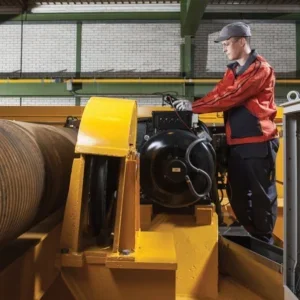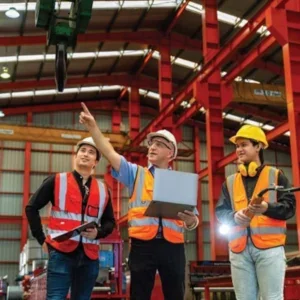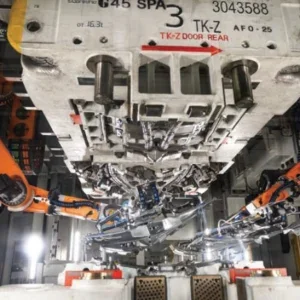For the next few years, at least, the economy should keep the industry bouyant. George Prest was appointed as CEO of the MHIA, the North American material handling equipment trade association at the start of 2012. "Last year was very good," he says, "Orders were up 15.1%, shipments up 17%. This year we expect 7% order growth and 9% shipments growth.
"It’s slowing down a bit this year, but will be picking up again in 2013. There’s money out there, there’s just a bit of uncertainty linked to the election."
That’s an analysis with which the MHIA’s expert consultant, Hal Vandiver, broadly agrees. Vandiver sees sustained corporate profits within the material handling industry. "In 2012 we’re going to grow I think some 8 or 9%. That’s going to be supported by continuing corporate profits."
"Corporate profits will fall off just a little bit this year but will return in the next year, which will boost growth in 2013 and 2014," says Vandiver.
Rising consumer confidence, and a returning housing market during this period will create more demand for material handling solutions.
"I believe as consumer confidence comes back and investor confidence remains high, that that is also going to support growth in 2013 and 2014," said Vandiver.
"The housing market that is so vitally important to our economy is now growing," he added.
The recession hit the materials handling industry hard, but it has been coming back with emphasis on efficiency, Vandiver said.
"At the end of 2008 we entered a recession, the deepest recession since the depression. This industry was off somewhere between 20-40%. Some segments were off 70-80%."
"2011 was a time to respond to the market as it came back. The last two years have presented opportunities throughout the materials handling industry for companies coming out of the recession to be more efficient and drive productivity.
Vandiver said: "One feature of this recovery is not that there has not been a lot of brand-new manufacturing because the capacity hasn’t been needed."
Some experts see manufacturing returning to the US, helping to boost material handling equipment over the longer term.
Rick Blasgen, CEO of the Council of Supply Chain Management Professionals spoke at the Modex Trade Fair on 8th February on trends within of the Logistics and Supply Chain Industry.
He reported increasing investments in supply chains, with many foreign manufacturing and distribution locations returning to the US.
Low oil prices kept delivery costs from other countries low, until the cost of a barrel of oil grew from $30 to $145.
"We made a bunch of decisions based on cheap oil, moved manufacturing to lower cost economies, searching for the lowest cost per pound of product produced," said Blasgen.
Cheap labor in ‘lower cost’ foreign economies is also becoming more expensive. "There’s a report from Boston Consultant Group which says that the manufacturing differential in China is going to close so far that within the next five years, a lot of companies will either be moving manufacturing either back to the States or to another lower cost economy," said Blasgen.
He added: "A lot of changes are happening and before you know it things begin to get more equalized."
The internationalization of supply has meant uprisings and disturbances abroad expose supply chains to greater risks.
"Because we have the opportunity now to source from lower cost economies, and more efficient economies possibly, our expanded supply chain is now held with more exposure," said Blasgen.
The US will need to form a national transportation policy to accommodate traffic increases with a return of industry.
Profits are increasing as the economy recovers from the recession. "Inventory returns have increased after three years of continued decline," Blasgen said attributing this in part to greater efficiency. Distribution centers and materials handling equipment users are expanding. "They’re having a great run, they’ll continue to have a great run," Blasgen says.
For decades, consumer goods have flowed across the Pacific from manufacturers in China to customers in the USA. Container ports, intralogistics yards and distribution centres flourished on the West Coast, as goods made their way by land to customers on the US East Coast. Now, with the expansion of the Panama Canal, this pattern of goods flow will change.
A report released in 2010 by ProLogis found that these impending capital investments on the East Coast have triggered supply chain professionals to "anticipate" a migration between the two coasts. According to the same report, railroads that dominate the eastern US are preparing for the increased traffic as well. "These railroads and East Coast ports are investing billions of dollars to fund capital improvements in the intermodal rail service between the East Coast ports and the major Eastern and Midwestern population centers," the report said.
The investments being made in southeastern states in preparation for the 2014 Panama Canal completion, are a "supporting factor in the coming build out of distribution center capacity," real estate broker Cushman and Wakefield told the MHIA. "Not only will more facilities be needed, but distribution networks may already be undergoing a significant shift."
Another strength for the region has been the growing automotive market, rivaling that of Michigan and the Midwest.Many foreign manufacturers are opening facilities in the South. Toyota alone has four facilities in the region, Nissan has three and Volkswagen has invested $1bn in a new plant, based in Chattanooga,Tennessee, that started production in 2011.
Southeast
Florida Handling Systems, which supplies a full line of material handling equipment, works all over the US, but mostly focuses on the southeastern states, explains vice president Joe DiCesare.
"We’re seeing little business from the Panama Expansion but are expecting it, hopefully, to pick up once it gets going," he says. "We’re getting inquires, and hoping they keep coming once the project gets into the thick of it and we are hoping to get some inquires in 2012." He says the market is flat in Florida, Georgia and South Carolina, but picking up in North Carolina, Tennessee and Virginia.
"There are a lot of manufacturers that are building in the area right now. That’s the reason the cranes and hoist industry is getting better there," he explains.
That is also the area where foreign automakers are expanding their US operations. The majority of demand for the automotive industry is from the manufacturers with a smaller portion coming from suppliers.
Despite the region’s potential DiCesare sees 2012 being similar to 2011 and expects improvement to happen in 2013 and 2014. This relies on a change in the current political environment to create jobs and incentives for manufacturing.
Mike Olsen, president of Equipment Fabricators, based in Cocoa, Florida, shares many of these observations. Business has been slow in Florida, but further north it gets better with a lot of work going on in the Carolinas and Georgia.
Equipment Fabricators hasn’t done much work with the automotive sector, having found opportunities doing large construction projects like building bridges. "Florida is non-industrial or light industrial. There isn’t enough work here," Olsen says.
The design-build company just finished a 10-year bridge project in New Orleans and has another order that is currently being designed for a bridge being retrofitted at the Panama Canal.
South
Rodney Torres, in charge of crane service and new crane sales for Gulf of Mexico operations for Standard Crane & Hoist, describes 2011 as being an "okay" year, with offshore drilling still halted for the oil industry. For Standard Crane, 2010 and 2011 were very similar for business with only a slight increase.
"There is a little bit more activity starting to trickle in, some rigs coming in," he says.
"But not nearly the same as before."
Torres hopes with the election in 2012, and with re-election on his plate, President Obama will loosen up federal regulations for the energy sector. "He’s going to have to do something with energy — the oil and gas [industry] isn’t going away any time soon," Torres says. "They need to do better with the permitting process, for example."
In the meantime, Standard Crane has been working on projects for a number of different end use sectors. While unable to pinpoint certain end sectors that are creating any notable portion of the work, most of the jobs are for fabrication and machine shops, and various types of service business have been expanding their shops to add cranes.
Searching for other customers has also led Standard Crane into opportunities producing compressor stations used in natural gas applications with spark resistant features and explosion proof cranes the past year.
However, Torres’ sights are set on 2012. "I would dare say from where we are at now, at least a 10% growth in 2012, again based on, I think the oil field is going to start coming back better."
Further up the coast, business is better. Mike Lipscomb, sales manager for new equipment, Piedmont Hoist & Crane, a custom bridge manufacturer based in Colfax, North Carolina, says, "For us the market down here has been fairly hot [in 2011], even through the slow down that a lot of people saw in 2009 and 2010. There has been a lot of large manufacturing that has been moving to the southeastern United States and we’ve been pretty successful in manning the projects."
Jeff Daugherty, regional sales manager for Gorbel, based out of Birmingham Alabama, saw strong growth in the market in 2011. He’s observed automotive customers, including tier one companies, spending more money, and there is increased government spending, too. But it’s hard to narrow it down to any one particular industry. "The largest amount of business is only 4% of the total business we do," he says.
However, he highlights several cities with automotive operations: "I see central Tennessee doing exponentially well — I see a lot of orders out of the Chattanooga area for the VW plant and tier one suppliers. I’m seeing growth in Mississippi. There are auto plants, they are tooling back up again."
West and Northwest
Looking at the Pacific Northwest, the region doesn’t have the same heavy industrial manufacturing compared to other parts of the United States. It’s not seeing the construction of new, large facilities that would require multi-USton capacity crane equipment. The manufacturing here requires a more technical focus, and the demand for overhead crane and hoist equipment is often based on specialized applications.
Neil Skogland, vice president of consultant Eureka! Engineering, explains further. "There is some significant manufacturing in both the Seattle and Portland [Oregon] marketplaces, but it’s not the place where you have an integrated steel mill."
Manufacturing in this region tends to be more technical, and therefore the demand for lifting solutions will be more technical in focus as well. The nature of the businesses in this region — high tech, aerospace, mining, and oil and natural gas — dictates what crane manufacturers and distributors need to supply customers.
Bill Trubits is a sales representative for Harrington Hoists, covering the Northwest, including Oregon, Washington, Idaho, Montana, Wyoming, Alaska and Hawaii. He says all of these locations are different, and what might be driving demand in Seattle and Portland varies greatly to the Rocky Mountain region, Alaska and Hawaii. Though there is one common demand, he says, "everyone’s got the same needs when you get down to it: energy, clean water and infrastructure."
Whether it’s Alaska, Hawaii or the metropolitan area of Seattle, every market requires infrastructure, refineries, wastewater treatment plants and power plants. "Everything has to be able to support itself. Especially if its an island or a remote area."
Skogland sees it similarly, saying military and hydro-power projects are market drivers, as the US Army Corps of Engineers, EPA and local public utilities all have significant hydro installations. "They’re looking for modifications, retrofits and rebuilds on a regular basis," he says. "Across the Pacific Northwest that’s a source of business from relatively small capacity, 1t or less, pieces of equipment that are replacements to 300t to 400t capacity cranes, that are typically control retrofits and mechanical modification jobs. That’s a significant piece of business today."
While the market for this region is quite diverse that wasn’t always the case says, Mike Currie, vice president of engineering, manufacturing and servicing company Washington Crane & Hoist. "A diverse range of end users hasn’t been historical for our particular area.
"We used to be just a western Washington company and 80 to 90% of our business was Boeing. We’ve supplied a lot of cranes to Boeing over the years and then we kind of branched out. We opened offices in Portland [Oregon] and Anchorage [Alaska]. We tapped into these other markets like petroleum, the mining industry and the military up in Alaska."
In Canada, Norelco Industries, manufactures and installs custom-designed heavy capacity overhead bridge cranes. General manager Keith Ellis reports the market slowed down in 2008, but has since picked up thanks to the mining industry.
"There a lot of mining projects that were put on hold that have gone gang busters," he says. "We have a couple of those projects, which are good for a crane company because they’re bigger projects that keep you going."
A lot of the work Ellis is quoting is for gold and palladium mines. "These customers need long spans and heavy capacities. The biggest process crane, the crushing crane, can be 50USt, 36m span, then down to 10USt with a 9m span in some of those buildings."
"We’ve supplied up into the Northwest Territories to the ice road mines a couple years ago. That was a big challenge. Everything had to be completed in a certain window to travel on the ice roads to site. And that was the same; there is only so much road capacity that can go on the ice roads."
Great Lakes
While it is easy to paint a portrait of crumbling infrastructure and derelict manufacturing facilities in the Great Lakes region, it wouldn’t be fair. New opportunities are slow to show, but still present.
Fred Pokrywka, district sales manager for the Great Lakes for Acco Material Handling Solutions, reports the states hardest hit during the economic downturn of the last few years — 2008 in particular — have been Michigan, Indiana and Ohio, and that’s mostly because of the decrease in automotive business.
What he is hearing from his distributors is automotive companies are not buying new cranes. Instead, when a manufacturing plant would close equipment would be removed and catalogued, essentially warehoused until they could be taken to another facility.
"As far as Michigan is concerned, for the most part, it appears that most of the dealers there are looking for work elsewhere," Pokrywka says. "Because Michigan is not offering up as much work as the area used to, based on the economy. They seem to be going for jobs out of state. That is where they are picking up a lot of their work."
"I will find distributors, for instance in Indiana, looking at jobs in Louisiana," Pokrywka explains. "If one of my distributors is in Maryland, for instance, he’s quoting on a job out in CO. How they do it and how they become competitive on that job I don’t know."
Looking to the Canadian region of the Great Lakes, by contrast, the automotive industry has been a lifeline in Ontario. Wayne Davies, general manager for O’Brien Installations, based out of Burlington, Ontario, says Toyota opened newer manufacturing facilities in the province, which have provided opportunities when previous sources of business have closed or slowed down.
He describes Hamilton, Ontario, as having always been a traditional steel town. "Whereas at one time we had two of the biggest, independent, Canadian-owned steel mills in North America, now they are both foreign-owned. There have been some changes that have come along with that. Production lines have been cancelled, for example, that has definitely affected things here."
Located in Sturgeon Bay, Wisconsin, along the coast of Lake Michigan, Kurt Minten, director of industrial sales for Shuttlelift has seen production of cranes and general manufacturing and fabrication move out of the country. "The Milwaukee area and going up the whole lake shore, there used to be many different companies and there are a lot of places closing and moving," he says.
"There has been a decline in the manufacturing taking place on the Great Lakes. It just moved elsewhere, be it Mexico or the southern United States where there are more favorable labor rates. We still do compete with those manufacturers. They are just now being built elsewhere in the country."
One area of growth that he notes is the power generation industry. Where other manufacturing has left the region, companies that build generator sets and other power generation equipment have been creating demand. This industry requires cranes to lift and move products.
Increasing demand for energy is the likely drive for this growth, and clean energy does have an impact — Shuttlelift has supplied cranes for companies that build towers for the wind industry, for example.
"I don’t know if it will ever catch up to what it is in Europe, but as the wind industry grows there is more demand," he says. "You see people going into those types of fabrication and that area is growing."
East Coast
A fairly strong rebound was experienced along the East Coast in 2010, helped by firms gearing up for work related to gas extraction the Marcellus Shale and the recommencement of projects postponed during the global financial crisis.
However even with continued public spending in the region, for those who have the means to cover a wider geography other regions seem to provide more of a draw.
Although crane builder G W Becker might seem to embody this view, with the lion’s share of its work sourced from around the Great Lakes region, the firm is still seeing significant prospects towards the Eastern seaboard.
"I would say 10% of our customer base is from the East Coast," explains Brent Rozar, marketing and sales manager for G W Becker. "It has been a mix of modernization projects and new installation work. Some projects have been expansion within the company, so it has been an even mix.
"Along the East Coast and Mid-West area we continue to see strong opportunities in that area and we have seen some inquiries for new facilities in the New York State area."
While based at a number of locations, Crane1Services has a similar area of operations to G W Becker, namely around the Great Lakes region, with its main office between Dayton and Cincinatti, Ohio. It also has premises in Columbus and Toledo, Ohio as well as in Indianapolis, Indiana; Louisville, Kentucky; Charleston, West Virginia; Richmond, Virginia and Baltimore, Maryland.
Having set up in Baltimore over a year and a half ago to undertake a military contract for work on Aberdeen Proving Grounds, the oldest active US Army proving grounds in America, the firm’s vice president of sales, Steve Harris acknowledges that some opportunities related to government military spending are still there.
"What brought us to Baltimore to begin with was a government contract with Aberdeen Proving Grounds," says Harris. "It was for inspection and maintenance on quite a number of cranes and hoists ranging from half-USt units to 20-30USt. Prospects are still reasonable. I think it’s much stronger in the Midwest and North than it is out East, but it’s reasonable."
The firm also set up a branch in Richmond, Virginia just over six months ago. "Our focus in Richmond is heavy industrial and our focus in Baltimore is government contracts with some industrial work as well. So far these have been military-type contracts, maintenance of the cranes on military contracts."
Despite the majority of its current workload coming form smaller accounts, Harris expects 2012 to be a very strong year for the firm, with growth plans for the region contributing.
"We have approximately six staff in Baltimore, and we have three in Richmond, so not very many yet.
"Our plan would be to continue to pursue the general industrial market and build crews of 15 to 20 each in each location."
Commenting on the region’ prospects in light of industrial growth around the Marcellus Shale, Harris says: "I think that it’s a good time to build a business right now. The metals business continues to be strong, primarily metals and metals producers continue to be strong."
However for G W Becker even with ‘reasonable’ demand in the region its East Coast projects represent a small proportion of its income.
Rozar says: "Our outlook for 2012 is positive. We carry a large backlog of work into the summer, currently including 15 orders for new cranes ranging in capacity from 1USt to 40USt, as well as a significant amount of field service projects.
"Our engineering department was augmented again this year with the addition of a structural design engineer. In addition our engineering manager obtained a PE licensure and continues to be an active community member on ASME B30.2 — Overhead and Gantry Cranes.
"If the recent trend of increased monthly sales continues as expected, our enthusiastic workforce of 50 people may need to be enhanced."
Likewise Crane1Services’ journey to the East seems comes on the back of a successful year in other areas. "Our sales are up over 60% in 2011 versus 2010, so we saw substantial growth in 2011. 2012 has been very strong so far," says Harris.
With this seemingly lukewarm demand along the East Coast, developments such as the closure of three oil refineries in Yorktown, Virginia, Marcus Hook and Trainer, Pennsylvania this month will doubtless have an effect on future prospects for modernization works on the East Coast.
Similarly President Obama’s endorsement this month of new offshore oil and gas exploration efforts in the Atlantic will be sure to produce a surge of opportunity for those already in place to take advantage.
So while demand in the East Coast may have steady and fairly flat and only very gradually improving for the past year, it is in this modest and steady recovery that some in the crane industry see the seeds of future prosperity. The question now will be if the region, and the US as a whole, can continue its growth through 2012 and into 2013.






